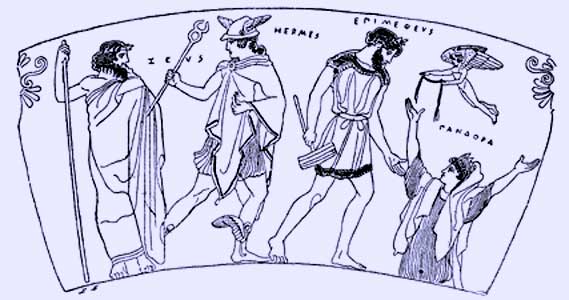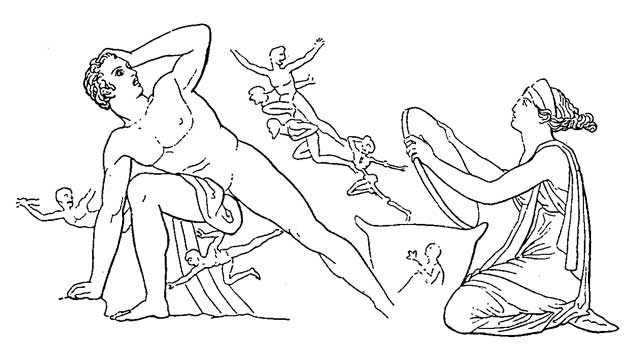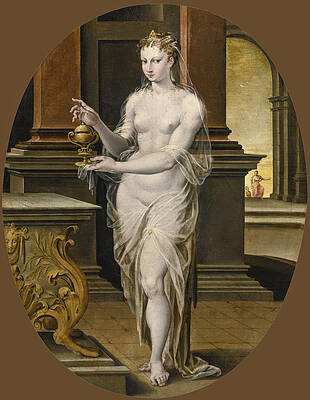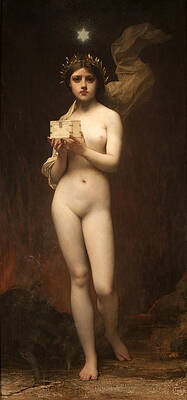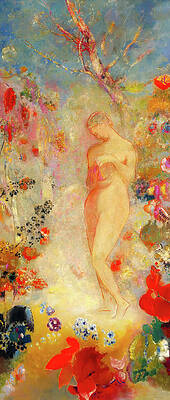.

The creation of Pandora; interior of a Cylix (470/ 460 B.C.)
In Greek mythology, Pandora (Πανδώρα)("all gifted") was the first woman, fashioned by Zeus as part of the punishment of mankind for Prometheus' theft of the secret of fire.
Hesiod, in his Works and Days, ca. 700 BC, has a very early version of the Pandora story. [1]
The legend
The titan Epimetheus ("hindsight") was responsible for giving a positive trait to each and every animal. However, when it was time to give man a positive trait, there was nothing left. Prometheus ("foresight"), his brother, felt that because man was superior to all other animals, man should have a gift no other animal possessed. So Prometheus set forth to steal fire from Zeus and handed it over to man.
Zeus was enraged and decided to punish Prometheus and his creation: mankind. To punish Prometheus, Zeus chained him in unbreakable fetters and set an eagle over him to eat his liver each day, as the eagle is Zeus' sacred animal. Prometheus was an immortal, so the liver grew back every day, but he was still tormented daily from the pain, until he was freed by Heracles during The Twelve Labours.
To punish mankind, Zeus ordered the other gods to make Pandora as a poisoned gift for man. Pandora was given several traits from the different gods: Hephaestus molded her out of clay and gave her form; Athena clothed her and adorned her with necklaces made by Hephaestus as well as taught her manual dexterity and how to spin; Aphrodite gave her beauty; Apollo gave her musical talent and a gift for healing; Demeter taught her to tend a garden; Poseidon gave her a pearl necklace and the ability to never drown; Zeus made her idle, mischievous, and foolish; Hera gave her curiosity; Hermes, along with giving her cunning, boldness and charm, then gave Pandora a box. The name Pandora, thus, derives from the fact she's received gifts from all deities: "all gifts".
Before he was chained to the rock, Prometheus had warned Epimetheus not to take any gifts from the gods. Epimetheus did not listen to his brother, however, and when Pandora arrived, he fell in love with her. Hermes told him that Pandora was a gift to the titan from Zeus, and he warned Epimetheus to not open the box, which was Pandora's dowry.
Until then, mankind had lived a life in a paradise without worry. Epimetheus told Pandora never to open the box she had received from Zeus. However, one day, Pandora's curiosity got the better of her and she opened it, releasing all the misfortunes of mankind (plague, sorrow, poverty, crime, etc.). Once opened, she shut it in time to keep one thing in the box: hope 1. The world remained extremely bleak for an unspecified interval, until Pandora "chanced" to revisit the box again, at which point Hope fluttered out. Thus, mankind always has hope in times of evil, but Hope has a great deal of catching up to do. (See also Garden of Eden.)
The daughter of Epimetheus and Pandora was Pyrrha, who married Deucalion and was one of the two who survived the deluge.
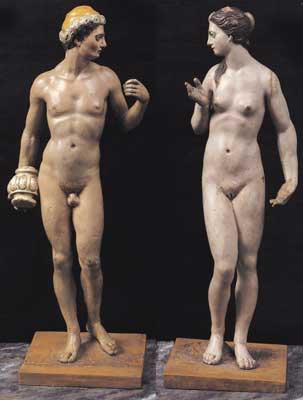
Epimetheus and Pandora, El Greco
Commentary
The story of Pandora's Box can be interpreted in more than one way, but one obvious moral is that of "curiosity killed the cat".
Some scholars 2 contend that Pandora's "box" may have been a mistranslation, and her "box" may have been a large jar or vase, forged from the earth. In fact, there is evidence 3 that suggests Pandora herself was the jar. In Ancient Greece jars commonly bore images of women. The jar was said 4 to have been in a jar form because of the similarites between a jar and a woman's uterus.
The mistranslation is usually attributed to the 16th Century Humanist Erasmus of Rotterdam when he translated Hesiod's tale of Pandora. Hesiod uses the word "pithos" which refers to a jar used to store grain. It is possible that Erasmus confused "pithos" with "pyxis" which means box. The scholar M.L. West, has written that Erasmus may have mixed up the story of Pandora with the story found elsewhere of a box which was opened by Psyche. 5
Hope 6 is considered an evil in this story because according to Hesiod it implies the control of the future, and since no one can control the future, to have hope is to be deluded. Other people think that Hope being left in the box symbolizes Hope often being humanity's only comfort.
The original Greek text from 700 BC of Hesiod's Works and Days, whence we get the earliest extant story of Pandora and the box, which is really a "jar", does not specify exactly what was in the box Pandora opened. 7
The scholar M.L. West has written that the story of Pandora and her jar is derived from a pre-Hesiodic story or legend and this is what causes the confusion and problems with Hesiod's version and its inconclusiveness. He writes that in earlier legends, Pandora was married to Prometheus, and cites the ancient Catalogue of Women as preserving this older tradition, and that the jar may have at one point contained only good things for mankind. There is also a question as to what was Hope, which is good for mankind, doing in a jar full of evils for mankind. Hence the earlier stories come into play. He also writes that it may have been that Epimetheus and Pandora and their roles were transposed in the pre-Hesiodic stories and legends. He remarks that there is a curious correlation between Pandora being made out of earth in Hesiod's story, to what is in Apollodorus that Prometheus created man from water and earth. (Apollodorus, Library and Epitome, ed. Sir James George Frazer.[2] ) 8
Martin P. Nilsson writes that the part about Hope being left in the box was likely added later: a sequel to the original legend. 9
The tale of Pandora's Box also shows how Early Greeks imagined woman to be created by the Gods as evil on the inside and beautiful on the outside in order to make men miserable. In this way, the tale has, on some superficial levels, similiarities with many Judeo-Christian stories.
Various feminist scholars believe that in an earlier set of myths, Pandora was the Great Goddess, provider of the gifts that made life and culture possible, and that Hesiod's tale can be seen as part of a propaganda campaign to demote her from her previously revered status. For an alternate view of Pandora, see Charlene Spretnak's Lost Goddesses of Early Greece; A Collection of Pre-Hellenic Mythology, 1978. For an alternate view of goddesses in general, and stories such as those of Eve and Pandora regarding women and evil, see Merlin Stone's When God Was a Woman.
Cultural allusions to Pandora and her box
- A play by Frank Wedekind, Die Büchse der Pandora in the original German;
- A film based on the Wedekind play directed by G. W. Pabst and starring Louise Brooks -- see Pandora's Box (film);
- A song in 2003 by Louise, "Pandora's Kiss". The lyrics refer to Pandora and the music video features Louise inside a box.
- Paul Auster's 1998 movie called Lulu on the Bridge;
- A video game designed by Alexey Pajitnov, the co-developer of Tetris
- A video game called Tom Clancy's Splinter Cell: Pandora Tomorrow features a storyline in which a terrorist leader prevents smallpox being released into the U.S. (alluding to not opening Pandora's Box) by calling the people in charge of keeping the containers, who are in the U.S., and saying the phrase "Pandora Tomorrow" as a life insurance policy for himself (i.e. If he is killed, then he cannot call, and smallpox will be released);
- In the video game God of War, Pandora's Box is the only weapon capable of killing a god; the main character, Kratos, opens the box and is made large enough to do battle with Ares.
- The story of Pandora's box has been told on an episode of the PBS children's TV show Between the Lions;
- The Box appeared in the Charmed episode Little Box of Horrors;
- One of the many phreak boxes is the possibly-fictional Pandora Box, which produces an extremely painful sound on the receiving telephone
- Pandora's Box was a key element in the second Tomb Raider movie, Lara Croft Tomb Raider: The Cradle of Life;
- Pandora's Box is the title of singer, Alberto's sophomore album;
- Pandora's Box is a commercial BDSM establishment in New York City that was the setting for Nick Broomfield's documentary Fetishes;
- An album with the name "Pandora's Box", created by the band Aerosmith; See Pandora's Box (album);
- Pandora's Box is central to the plot of a novel by Gene Wolfe: "Pandora by Holly Hollander";
- Adam Curtis' Pandora's Box documentary film;
- Tori Amos has a song called "Pandora's Aquarium" on her album From The Choirgirl Hotel which also references Persephone;
- On the television sitcom Bewitched, Samantha Stephens's lookalike cousin Serena is credited as "Pandora Spocks", a play on "Pandora's Box." (The name is a pseudonym for Elizabeth Montgomery, who played both Serena and Samantha.)
- The Music Genome Project's music discovery service has taken Pandora's name;
- The first movie in Steven Chow's A Chinese Odyssey films is subtitled Pandora's Box, referring to a box in the film which can transport people back into time, but is not related to the Greek myth in any way;
- In Lost (TV series), Locke is asked what he hopes to find in the hatch, and answers Hope.
- In the book "Pandora's Planet" by Christopher Anvil, Earth is conquered by dimwitted aliens who then get taken advantage of by the much smarter humans ("Want to trade that spaceship for some lovely swampland in Florida?")
- In the video game House of the Dead 4, the Pandora's Box project unleashes a horde of zombies and attempts to activate a network of nuclear missiles. According to the plot of the game, the last and most powerful one among them had to be defeated for humanity to prove itself worthy of survival.
- Pandora is the name of the UK Independent newspaper's diary column, known to be a 'box' of delights.
- Pandora and Pandora's Box play a major role in the anime and manga series Violinist of Hamelin.
- Bounty mutineers and loyal crew alike, were imprisoned in a makeshift cell on HMS Pandora's deck, which they derisively called Pandora's Box.
- In the Crimson Skies universe, the home airship of Nathan Zachary's "Fortune Hunters" pirate gang is named Pandora in direct allusion to the legend. Zachary makes it deliberately ambiguous as to whether his Pandora is a wellspring of all the world's mischief, or the last bastion of Hope.
- El Pozo de Pandora, a book written by an Uruguayan author, Enrique Ortega Salinas, in 2002, in which corruption and crime in the government is revealed.
- Pandora's Box is the first in a trilogy of Fantastical adventures having some roots to mythology but an absolutely different timeline, called Land of Illusions.
- Zombies Ate My Neighbors, a video game made in 1993 for the SNES, allows the player to use Pandora's Boxes as weapons. They act as smart bombs, releasing magical sparks that fly around and kill all enemies on-screen.
- Anne Rice's Vampire Chronicles features an ancient vampire named Pandora. One book in the series, entitled Pandora: New Tales of the Vampires, is dedicated exclusively to her story.
- Final Fantasy 6, a video game made in 1994 for the SNES, features an enemy by the name of Pandora's Box.
- In Age of Mythology, "PANDORAS BOX" is a cheat code which will give you four random god powers.
Notes
1 C.H. Moore, p.37: the word for "hope" in Greek, Ελπις, "elpis", and its context in Hesiod's Works and Days, line 96, Moore claims is better translated as "anticipation of misfortune" rather than simply "hope". It is presumed that Moore is saying that mankind could avert some misfortunes by anticipating them with what was left on the rim of Pandora's jar. Some Greek lexicons yield some support to Moore's observation. Moore's exact words on the subject, on page 37, are: "She [Pandora] opened a jar containing every kind of evil, which straightaway flew out among mankind. Only Ελπις [elpis] remained therein --- a word hardly equivalent to our Hope, but rather meaning 'anticipation of misfortune'. It is then the only plague to which man is not subjected. He is obliged to suffer, having been involved in the original sin of Prometheus, who wished to cheat Zeus of the sacrifice due him. Such is the sacred tale offered as an explanation of the presence of evils on earth". M.L. West also has an exposition and commentary on the word used, on p.169 of his Works & Days / Hesiod, edited with prolegomena and commentary. Pietro Pucci, in his Hesiod and the Language of Poetry, also addresses the full meaning of Ελπις, p.124, ff.51 and says "Ελπις properly means a larger set of expectations than our 'hope', for it implies hope, expectation, and even fear as in Homer's Iliad 13:309, 17:23, etc." Pucci goes on to write on p.104, that Hope was not always considered simply good for mankind, citing Works and Days by Hesiod, line 498 [500], "Hope [Ελπις] is a bad companion for the man in need who sits in an idle place, when he has no sufficient livelihood".
2 Hesiod, Works and Days, translation of the word as jar, not box. The word in the Greek text is πιθου ("pithou", from the base "pithos") which describes "a very large jar, usually made of rough-grained terra cotta, used for storage".[3] [4] The classics scholar, M.L. West, writes about this issue on p.168, in his translation and commentary on Hesiod's Works and Days, confirming it was a jar, and not a box, and the many implications of that. For example, it was likely a jar as large physically, if not larger than a person. Cf. the original text of Hesiod, lines 90, 95. "[90] For ere this the tribes of men lived on earth remote and free from ills and hard toil and heavy sicknesses which bring the Fates upon men; for in misery men grow old quickly. But the woman took off the great lid of the jar with her hands [95] and scattered, all these and her thought caused sorrow and mischief to men. Only Hope remained there in an unbreakable home within under the rim of the great jar, and did not fly out at the door; for ere that, the lid of the jar stopped her, by the will of Aegis-holding Zeus who gathers the clouds. [100] But the rest, countless plagues, wander amongst men; for earth is full of evils, and the sea is full. Of themselves diseases come upon men continually by day and by night, bringing mischief to mortals silently; for wise Zeus took away speech from them". [5]
3 Padraic Colum, Orpheus, Myths of the World, p.71, 1930. "The jar, like Pandora herself, had been made and filled out of the ill-will of Zeus. And it had been filled, not with salves and charms and washes, as the women thought, but with Cares and Troubles." [6] This should be viewed with scholarly skepticism as it is an extrapolation to see Pandora being the vessel herself.
4 Sujoy Deyasi, Uniphase: A Solution to Albert Einstein's the Unified Field Theory, 2003. "In the story of Pandora the box is representing a woman's womb (the uterus, the vessel in which a new life arrives in this world), and opening of it either by Pandora or by her husband god Epimetheus is referring to our conscious knowledge that we can have sex anytime. What came out of the box is human emotion." [7] This claim should be viewed with scholarly skepticism as it is far from the mainstream. It is only included here to fulfill a prior citation.
5 cf. M.L. West, Works & Days, p.168
6 cf. note 1.
7 cf. M.L. West, Works & Days, p.168. "Hesiod omits to say where the jar came from, and what Pandora had in mind when she opened it, and what exactly it contained". West goes on to say this contributes to the "inconclusive Pandora legend".
8 cf. M.L. West, Works & Days, p.164.
9 cf. Martin P. Nilsson, History of Greek Religion, p.184.
Pandora, William-Adolphe Bouguereau
Pandora, Barend Graat
Pandora, School of Fontainebleau
Pandora, Jules Joseph Lefebvre
Pandora, James Smetham
* Pandora, Kirk Richards (1952-) 2002
References
- Clifford H. Moore, The Religious Thought of the Greeks, 1916.
- Hesiod, Works and Days, 700 BC
- Nilsson, Martin P. History of Greek Religion, 1949.
- Pucci, Pietro. Hesiod and the Language of Poetry, 1977.
- Smith, William, Dictionary of Greek and Roman Biography and Mythology, 1870, article on Pandora, [8]
- Martin Litchfield West, Works & Days / Hesiod, edited with prolegomena and commentary by M. L. West, Oxford, Clarendon Press, 1978.
- Martin Litchfield West, The Hesiodic Catalogue of Women: its nature, structure, and origins, Oxford, 1985. ISBN 0198140347
|
Genealogy of Hellenes |
|||||||||||||||||||||||||||||||||||||||||||||||||||||||||||||||||||||||||||||||||||||||||||||||||||||||||||||||||||||||||||||||||||||||||||||||||||||||||||||||||||||||||||||||||||||||||||||||||||||||||||||||||||||||||||||||||||||||||||||||||||||||||||||||||||||||||||||||||||||||||||||||||||||||||||||||||||||||||||||||||||||||||||||||||||||||||||||||||||||||||||||||||||||||||||||||||||||||||||||||||||||||||||||||||
|
|||||||||||||||||||||||||||||||||||||||||||||||||||||||||||||||||||||||||||||||||||||||||||||||||||||||||||||||||||||||||||||||||||||||||||||||||||||||||||||||||||||||||||||||||||||||||||||||||||||||||||||||||||||||||||||||||||||||||||||||||||||||||||||||||||||||||||||||||||||||||||||||||||||||||||||||||||||||||||||||||||||||||||||||||||||||||||||||||||||||||||||||||||||||||||||||||||||||||||||||||||||||||||||||||
Music
- Kazumi Watanabe (1953-) Pandora (1992)
- Makoto Ozone, Pandora
Links
- Pandora and Strife: The Mistaken Perception of Misogyny in Hesiod
See also : Greek Mythology. Paintings, Drawings
| Ancient Greece
Science, Technology , Medicine , Warfare, , Biographies , Life , Cities/Places/Maps , Arts , Literature , Philosophy ,Olympics, Mythology , History , Images Medieval Greece / Byzantine Empire Science, Technology, Arts, , Warfare , Literature, Biographies, Icons, History Modern Greece Cities, Islands, Regions, Fauna/Flora ,Biographies , History , Warfare, Science/Technology, Literature, Music , Arts , Film/Actors , Sport , Fashion --- |
Retrieved from "http://en.wikipedia.org"
All text is available under the terms of the GNU Free Documentation License

